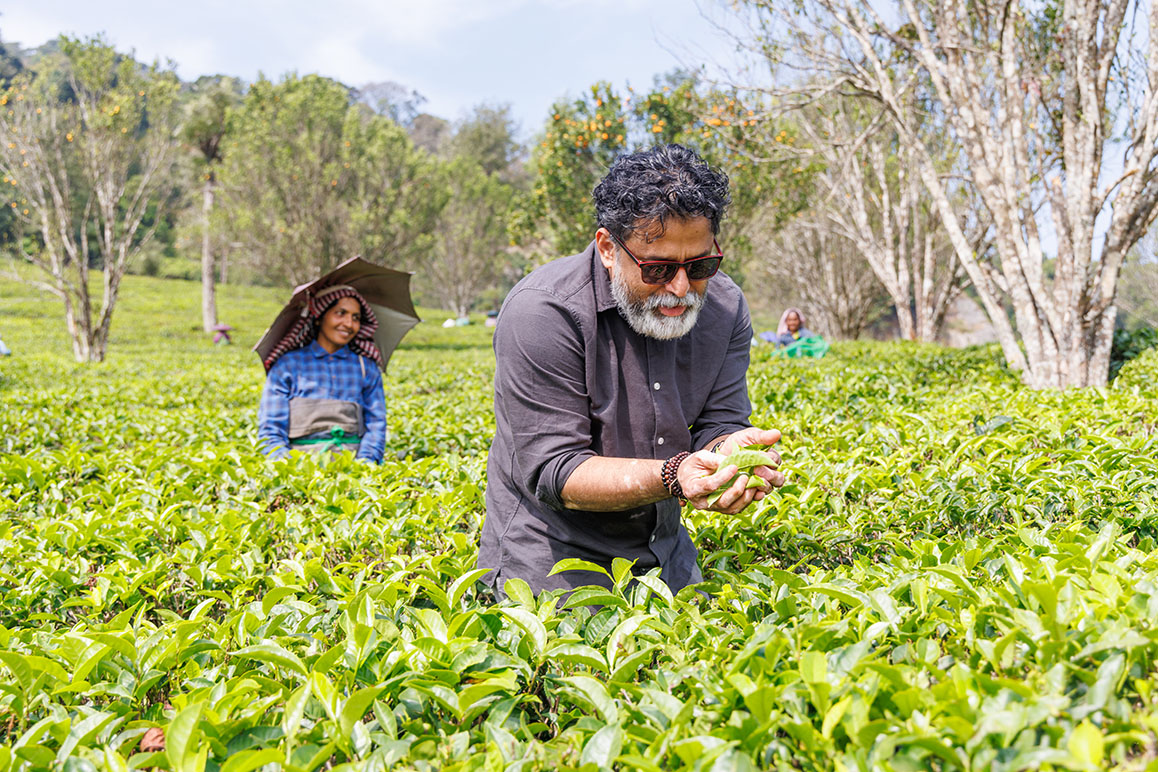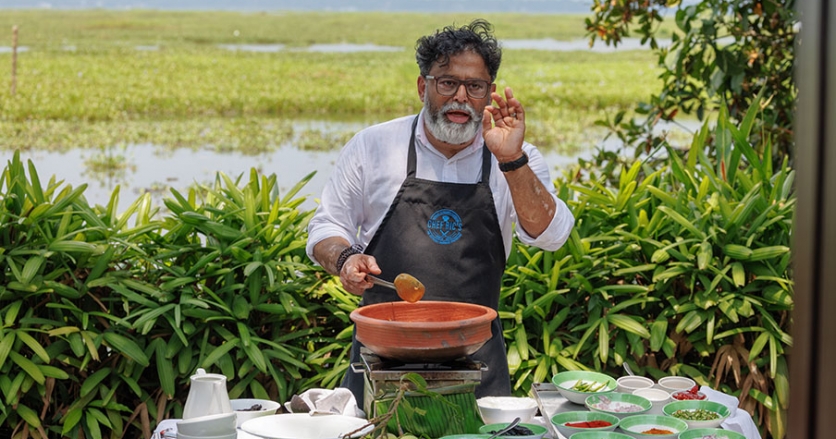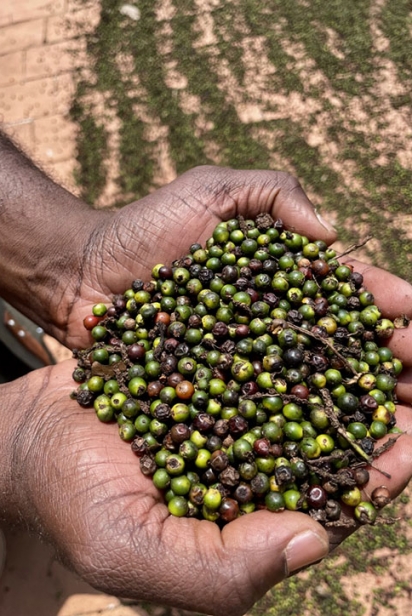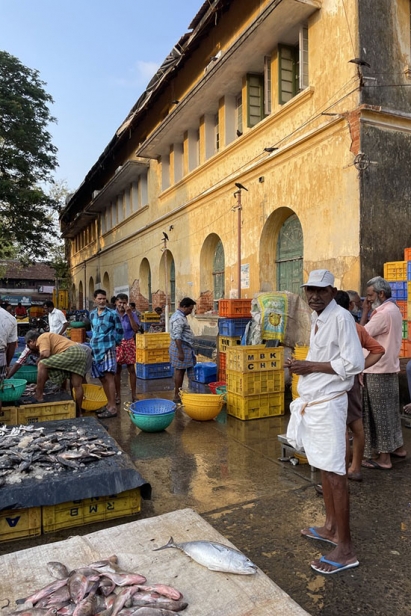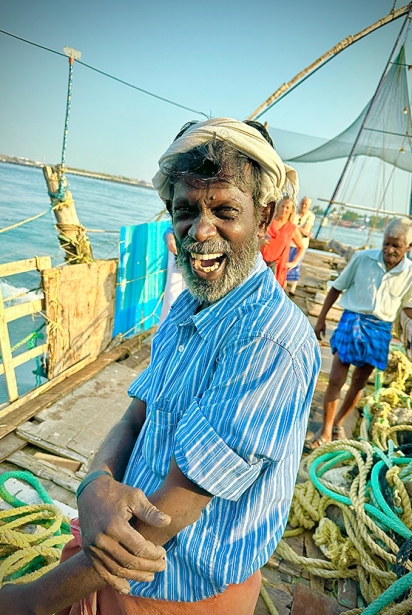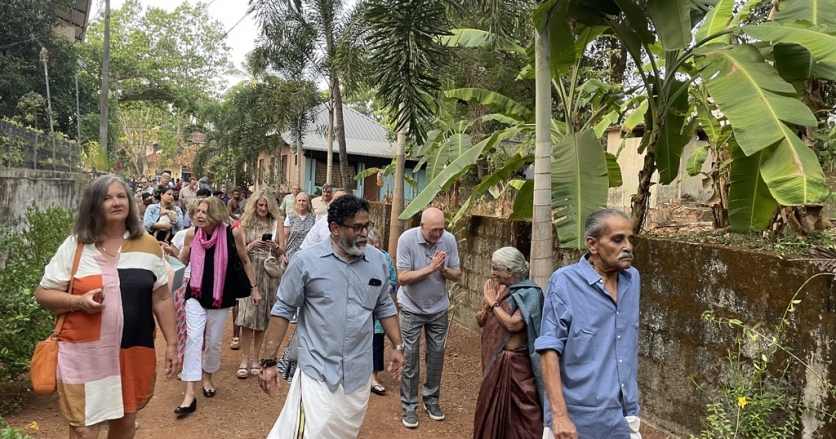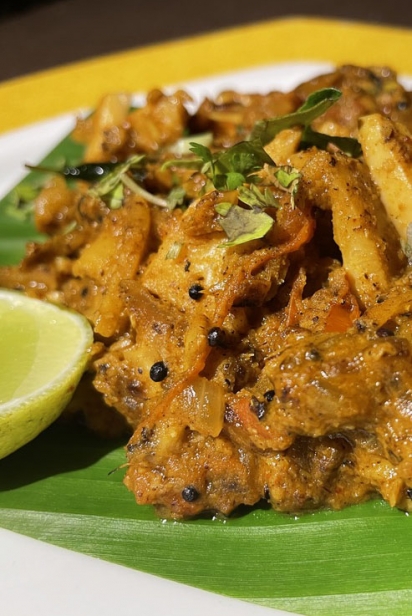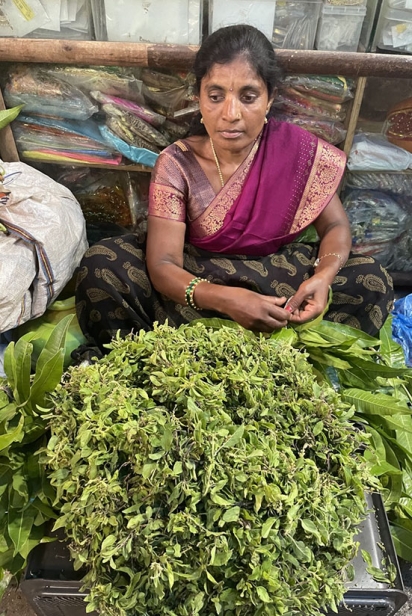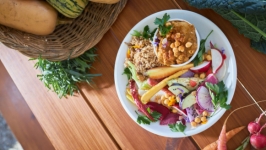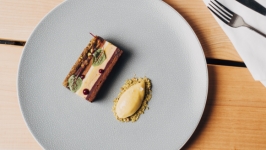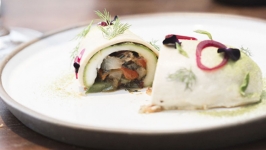Joe Thottungal's India
The music is loud, percussive, joyous and unrelenting. Drums and cymbals set the beat and horns come in to break up the hypnotic rhythm. The 11 musicians — part of a panchavadyam group always made up of at least five musicians playing five different instruments — play at the side of an urban road in Thrissur, seat of the Thottungal clan.
Next to them is a pillar with a sign that reads “Thottungal” in an all-caps serif font. And the affable chef stands next to it and it’s clear he’s home, and in his element. It’s the tenth day of a 17-day culinary tour of his homeland of South India that he’s helping to guide.
The tour started in Bangalore and Thottungal has already explained to a group of 20 Canadian and two Briton travellers that as the bus moves further south, he gets more excited because soon, he’ll be in Kerala, a southwestern state of India and the place where his parents and one of his three brothers still live. The other two brothers live in Canada and help to run his growing empire of restaurants — first Coconut Lagoon and more recently, Thali.
As the tour participants break for a late lunch and settle in their hotel in Thrissur, Thottungal has gone to be with his parents, his mother, Mary, 75, and his father, Joseph, 80. Tonight, he’ll sleep in the home he grew up in and wake up to breakfast prepared by his mother, the woman whose masala spice mix he took to Ottawa more than 22 years ago to launch his first restaurant.
The panchavadyam greets visitors on the roadway as they disembark from the bus and acts as the head of the procession into the property, set back about 300 metres from the road. Outside the home, there’s a dining area delineated by colourful drapery for the party the Thottungals are hosting as part of the tour.
Thottungal’s ancestral home is an oasis in an urban setting and it’s surrounded by acres of food-bearing trees, including palms, with bright green peppercorn vines growing up their trunks.
“When I tell people in Ottawa that there are peppercorns growing in my parents’ yard, they can’t fully understand,” Thottungal says.
There are luscious jackfruits hanging from their trees and papaya trees in the distance. Cashew nuts, green chilis, coconuts and bananas — some of Kerala’s 350 varieties — grow here, too. The Thrissur region is verdant and warm, full of plantations and a magnet for tourists — Indians and foreigners alike — looking for a little getaway.
“This is green chile, and this is lime,” Thottungal says, pointing to plants in his homestead’s garden before he points out a big bowl of freshly picked cashews.
As she walks around the plantation, Mary Thottungal talks about her son’s success and how proud she is of him. In his halting English, Joseph expresses similar sentiments as does his brother, Anoop.
“He went to Canada and set up all these things,” Anoop says. “He put his all in, risked everything and now it’s doing well. It is very tough to do what he’s done. It took a lot of hard work and determination. We are proud of him.”
Thottungal and his mother offer a tour of the property, with Mary cracking a coconut with the skill of a woman clearly does it every day of her life. The fruits of the coconut play an indispensible role in South India’s distinctive cuisine.
Thottungal has invited his aunts and uncles from both sides of his family, and any of their children who live within the area and he’s arranged for a buffet of Kerala delicacies, including locally caught sardines and karimeen fish baked in a banana leaf — it’s an “en papilotte” treatment, Indian style. There is parotha, a flaky unleavened bread typical of the region, and the ever-present coconut-based chutneys — coriander, coconut and tomato — and pickles.
It’s a joyous occasion. Thottungal’s jubilant mood is partly because he’s hit the highlight of this tour and also because he’s just published his second cookbook, My Thali, after the success of his first, Coconut Lagoon. There’s a copy of it on the coffee table in his parents’ home. The next day, the tour will go to Viswajyothi College of Engineering & Technology, where Thottungal serves on the board of directors and is a proud and influential patron of the culinary arts program.
An annual tradition
Thottungal began doing this trip eight years ago, and has continued to do so most years, with a break in 2021 and 2022 due to the pandemic. The inaugural trip, in 2015, concentrated on the Cochin area, but over the years, he and the team from Bestway Tours have refined and expanded it, sometimes adding visits to some North Indian cities. Thottungal has since concluded, however, that he’d rather confine tours to where he’s most comfortable, and those are the states of Karnataka and Kerala.
The 2023 tour starts in Bangalore, and features mostly two-night stays in a trajectory that winds its way from the Taj Bangalore, a swish five-star hotel near the airport in the capital of Karnataka state and a visit to a craft brewery and restaurant that produced poppadum bowls the size of half-beachballs, to Mysore, which was the capital of the Kingdom of Mysore between 1399 and 1947. Mysore is one of two cities on the tour, with Cochin being the other. Besides Thrissur to see the Thottungals, the tour generally confined itself to five-star eco-lodges in the mountainous terrain between Bangalore and Cochin. Wildlife on view included elephants, birds and highly mischievous macaque monkeys. On the final evening of the tour, guide Charls Gnanaraj — who bends over backward to accommodate the guests’ every whim, including sending tuktuks for beer runs and taking travellers to specific markets and boutiques to get the best deals — buys saris and dotis for the travellers and all don them for a final feast at a posh restaurant overlooking the water in Cochin.
Coffee in India?
When one imagines India’s morning beverage, tea surely springs to mind. But think again. In 2023, India produced 393,000 metric tonnes of coffee, putting it sixth in the world for coffee production, putting it ahead of such famous coffee-producing countries as Peru and Guatemala.
As the tour hits its third stop of Coorg, coffee plantations spring up across the landscape. The principal coffee-growing states are Karnataka, Kerala and Tamil Nadu with Karnataka being home to the Evolve Back Chikkana Halli Estate, which is built on a coffee plantation. The coffee grown here is all robusta, which is the variety that’s highest in caffeine (arabica provides all the rich coffee taste, but has less caffeine so most roasters make a 20:80 robusta-arabica blend.) Robusta, which is grown under a canopy of trees, grows here under tall palm trees that also support the many peppercorn vines that climb up their limbs and that plantation workers harvest by climbing on flimsy handmade bamboo ladders that would make a workers’ compensation inspector combust. The coffee beans, meanwhile, are found in the plant’s red berries. Remove the pulp, and inside, you’ll find a green bean that is ripe for roasting.
Coffee’s history in India goes back a long way — in the 1600s, a Sufi saint named Baba Budan smuggled seven seeds when he was returning to India from a pilgrimage to Mecca that included a stop in Yemen’s Mocha, which had imported its coffee trade from coffee’s native Ethiopia. He planted the seeds on the slopes of Chandragiri in Karnataka and from there, Indian coffee blossomed across the region.
In the Evolve Back restaurant each morning, guests are treated to Indian filter coffee, a drink made with hot milk, sugar and an 80:20 coffee-chicory blend. The result is a more robust flavour than the drip coffee the travellers drink at home. They can also visit the plantation’s coffee museum and be treated to a coffee tasting.
The plantation has an impressive restaurant and villas for guests. Each one-bedroom villa is the size of a small bungalow and has its own pool in the backyard.
Tea for two
The hills in Munnar in the Western Ghats mountain range in Kerala are steep and undulating, with rows and rows of bright green shrubs (they’re trees, actually, that are kept short so the tea leaves remain young and non-bitter.)
Attached to the Munnar Tea Museum, the Kanan Devan Hills Plantation is the largest tea estate in South India and the largest employee-owned tea company in the world. It just achieved a carbon neutral and net negative emission status, something for which many of the resorts on the tour were striving. There were efforts to reduce the amount of laundry they do and to eliminate plastic by creating their own water filtration systems and filling and reusing glass bottles for guests.
Tea may be more instinctively native to India than coffee in North Americans’ minds, but tea is also an imported product. It was brought to this area in the early British Colonial Raj era to rival China’s monopoly in tea production.
Tea came to Munnar thanks to a Briton named James Daniel Munro. He was visiting the region to settle a border dispute in the 1870s and fell in love with the landscape, which must have looked quite different before the tea plants carpeted the countryside. He decided the Kanan Devan Hills looked good for crops and he brokered a lease with the landlord and established the North Travancoure Land Planting & Agricultural Society in 1879. The group started experimenting with crops and eventually landed on tea as the most promising. The Kanan Devan Hills Produce Company was founded in 1896. It still operates today, alongside a tea museum and gift shop.
Today, India is the second-largest producer of tea worldwide and a full 70 per cent of it remains in India for the local population to consume, usually with spices, warm milk and sugar. At this plantation, they make white, green and black, red and brown teas, the former with the youngest leaves on the tree, before they have fully opened. Processors dry them immediately to stop them from oxidizing. Black, red and orange teas are dried at 104 C.
Tea pickers can be seen high in the hills, harvesting leaves and putting them in large mesh bags they carry on their heads. They are unionized and therefore receive relatively fair wages and have decent working conditions.
Spice, spice, baby
Nothing says India like spices and Kerala grows many of the typical ones. A stop in Thekkady took the tour to the Green Park Spice Plantation where they grow cinnamon (the proper bark kind, not the curled sticks of cassia cinnamon sold in Canadian grocery stores), green and black cardamom, peppercorns, coriander, nutmeg, cloves, bay leaves and cocoa.
The tour guide at this family-owned plantation is full of spice wisdom and knowledge.
“Cardamom will only grow at more than 2,500 metres above sea level,” he tells the group — something that doesn’t surprise the travellers as most of the time in this state has been spent in picturesque hills. He also imparts some good advice on spices. Whole dried spices, he said, will last for upwards of 10 years while ground spices last six months.
Cloves on the vine are yellow in colour, but look like their dried counterparts in shape. Vanilla vines, which climb up other trees, were growing throughout the plantation.
Also surprising to some was the fact that white, green, red and black peppercorns all come from the same plant. Green peppercorns are harvested and treated in two ways: some are dried in air-tight, heated chambers, allowing them to keep their green colour, others are dried in sunlight, which turns them black, giving us the ubiquitous black peppercorns. Red peppercorns are green ones that have ripened on the vine, are dried again in airtight conditions so they keep their colour. Dried in the sun, they too will yield black peppercorns. White peppercorns might be the most labour intensive. They are seeds from the middle of red peppercorns with the red pulp removed before they are dried. To remove the pulp, they put red peppercorns in water and allow the pulp to decay.
“They’re all the same plant, processed differently,” the guide says, adding that pepper vines needs support trees to climb up. Jackfruit is a good choice for them, he adds.
The guide points out some red ants, which he notes are actually pollinators for peppercorn and cardamom plants. The other perhaps surprising pollinators of pepper plants are the monsoon rains that come in June, July and August.
Cocoa, while not native to India, has become an important crop. Cadbury buys Green Park Spice’s cocoa yields.
The members of the family that own the plantation follow Ayurvedic practices, as do many in Thekkady, where unique Ayurvedic massages are also available and reasonably priced. At the end of the plantation tour, before a visit to the spice gift shop, the family offered a spice-filled home-cooked lunch, served on banana leaves instead of plates and eaten in the Kerala way — with one’s hands, the right one only.
Indian culinary insights
Throughout the tour, Thottungal offers cooking demonstrations, sometimes with other chefs, sometimes on his own. He imparts gems of tips to the travellers, most of whom enjoy cooking and want to learn from the master.
Every recipe begins by making a masala — in this case always a dried spice mixture that ends up giving curry its distinctive taste. In a kitchen in the treetops of Wayanad, deep in the Indian rainforest and a 3.5-kilometre trip up a winding dirt road only accessible by Jeep, Thottungal is making a fish dish, a chicken curry, a raita and some poppadums.
This masala has cardamom, cinnamon, coriander, star anise, cloves and Thottungal says it’s similar to his except he doesn’t use coriander. He also says many chefs have no real set recipe.
“We don’t measure in our cooking,” Thottungal says. “Our moms and grandmothers never measure. They take a pinch of this and a pinch of that.”
Next comes roasting or tempering the spices. As the flavours develop in the pan, it’s time to remove them. He grinds them into a powder in a mortar and pestle, but admits most commercial kitchens now use an electric grinder with stone inside.
“When you’re cooking with meat, leave the bones because they add flavour,” he says. “We don’t add stocks and things so the bone marrow adds a lot.”
To start the curry, he tempers the spices in coconut oil until their aromas release or, if there are mustard seeds, until they start to pop.
Another tip: Adding salt to onions will make them sweat faster. And another: “Don’t discard the stems from cilantro — use them. The stems have good flavour.”
To make the fish dish, he uses mahi mahi and the leaves of the pepper plant. He cuts a slit into the filet to form a pocket and he stuffs it with a paste made of shallots, green chilis, lime juice and black pepper and tops it with some turmeric. Then he places the fish in the pepper leaves and gently cooks it in a clay pot, finishing with some coconut milk. The process is similar for the curry.
Thottungal presents cooking classes in Coorg, Wayanad, Munnar and Thekkady, often collaborating with the resort chefs, but always adding his signature twist. On the penultimate day of the tour, the travellers visit Nimmy Paul, who is known as South India’s Julia Child and offered a cooking demonstration, followed by a multicourse meal. Behind her demo kitchen, a glassed-in bookcase boasts Thottungal’s first cookbook and he added his second to her collection during that visit.
If you haven’t seen South India through Chef Thottungal’s eyes, Jennifer Campbell says you’re missing out. His trips take place most winters between February and March. Contact Bestway Tours & Safaris for details.
FAVOURITE TIPS OF THE TRAVELLERS
· “Fanning and smelling the tempering spices in the pan to determine if the balance is right. Also, watching Joe deseed a pomegranate by knocking it with the flat of a knife blew my mind.” — Barbara Warren
· “Always capture the subtly brilliant injections of fresh of coconut, onions, cardamom and skillfully ground garam masala into every dish.” — Heather Paszkowski
· “Learning to properly toast the spices before you crush them with mortar and pestle was helpful. Also, his quick test on making sure your oil is hot enough to cook with [by putting in a small piece of poppadum to see if it sizzled.]”
· One tip no one mentioned is the importance of sharp knives. Also, that [when the real stuff isn’t available], powdered coconut makes better coconut cream/milk than the canned stuff.” — Valerie Proctor
· “Squeeze fresh lime juice on everything.” — Warren Creates


